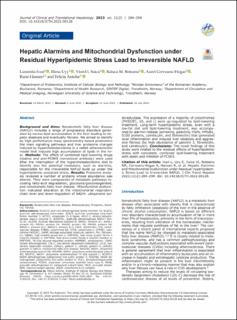Hepatic Alarmins and Mitochondrial Dysfunction under Residual Hyperlipidemic Stress Lead to Irreversible NAFLD
Ivan, Luminita; Uyy, Elena; Suica, Viorel; Boteanu, Raluca; Cerveanu-Hogas, Aurel; Hansen, Rune; Antohe, Felicia
Peer reviewed, Journal article
Published version
Date
2022Metadata
Show full item recordCollections
- Publikasjoner fra CRIStin - SINTEF AS [5801]
- SINTEF Digital [2501]
Original version
Journal of Clinical and Translational Hepatology (JCTH). 2022, 11 (2), 284-294. 10.14218/JCTH.2022.00128Abstract
Background and Aims: Nonalcoholic fatty liver disease (NAFLD) includes a range of progressive disorders generated by excess lipid accumulation in the liver leading to hepatic steatosis and eventually fibrosis. We aimed to identify by high performance mass spectrometry-based proteomics the main signaling pathways and liver proteome changes induced by hypercholesterolemia in a rabbit atherosclerotic model that induced high accumulation of lipids in the liver.
Methods: The effect of combined lipid-lowering drugs (statins and anti-PCSK9 monoclonal antibody) were used after the interruption of the hypercholesterolemic diet to identify also the potential mediators, such as alarmins, responsible for the irreversible NAFLD build up under the hyperlipidemic sustained stress.
Results: Proteomic analysis revealed a number of proteins whose abundance was altered. They were components of metabolic pathways including fatty-acid degradation, glycolysis/gluconeogenesis, and nonalcoholic fatty liver disease. Mitochondrial dysfunction indicated alteration at the mitochondrial respiratory chain level and down-regulation of NADH: ubiquinone oxidoreductase. The expression of a majority of cytochromes (P4502E1, b5, and c) were up-regulated by lipid-lowering treatment. Long-term hyperlipidemic stress, even with a low-fat diet and lipid-lowering treatment, was accompanied by alarmin release (annexins, galectins, HSPs, HMGB1, S100 proteins, calreticulin, and fibronectin) that generated local inflammation and induced liver steatosis and aggressive fibrosis (by high abundance of galectin 3, fibronectin, and calreticulin).
Conclusions: The novel findings of this study were related to the residual effects of hyperlipidemic stress with consistent, combined lipid-lowering treatment with statin and inhibitor of PCSK9.

